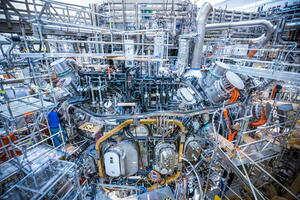New records on Wendelstein 7-X
Wendelstein 7-X—the leading fusion device of the stellarator type—achieved several new performance milestones during its latest run of experiments. Among them is a world record for triple product, the value that measures how close a fusion device is to generating net energy across the plasma.
Also called the Lawson Criteria, fusion triple product defines the threshold that must be exceeded for a plasma to produce more fusion power than the heating power injected. It marks the point where the energy balance across the plasma becomes positive, and the fusion reaction can sustain itself without (or with greatly reduced) external heating. The triple product is derived from three factors—ion temperature (T), density (n) and energy confinement time (τ). In any future fusion power plant, a plasma with a high triple product must be maintained for long periods.
On the last day of its OP 2.3 campaign, which ended on May 22, the Wendelstein 7-X device sustained a new peak value of this key fusion parameter for 43 seconds. While high values of fusion triple product have been achieved during plasma durations of a few seconds in devices like JT-60U (Japan, decommissioned in 2008) and JET (Europe), this is a new world record for triple product in long plasma discharges.
"Elevating the triple product to tokamak levels during long plasma pulses marks another important milestone on the way toward a power-plant-capable stellarator," said Thomas Klinger, Head of Operations at Wendelstein 7-X and Head of Stellarator Dynamics and Transport at the Max Planck Institute for Plasma Physics (IPP) in Greifswald, Germany.
According to the IPP press release, the triple product world record for long pulses was made possible by the close collaboration between the Wendelstein 7-X team in Greifswald, the European fusion consortium EUROfusion, and partners from the United States. A pellet injector developed at the Oak Ridge National Laboratory fuelled the plasma with a steady supply of hydrogen particles and permitted the long plasma durations achieved. Other laboratories in Europe and the United States provided the diagnostics to measure the different factors entering into the triple product calculation.
During the campaign, the team also obtained milestones for energy turnover (maintaining continuous high-energy input and removing the generated heat) and plasma pressure relative to magnetic pressure.
“The records of this experimental campaign are much more than mere numbers," said Robert Wolf, Head of Stellarator Heating and Optimization. "They represent a significant step forward in validating the stellarator concept—made possible through outstanding international collaboration.”


